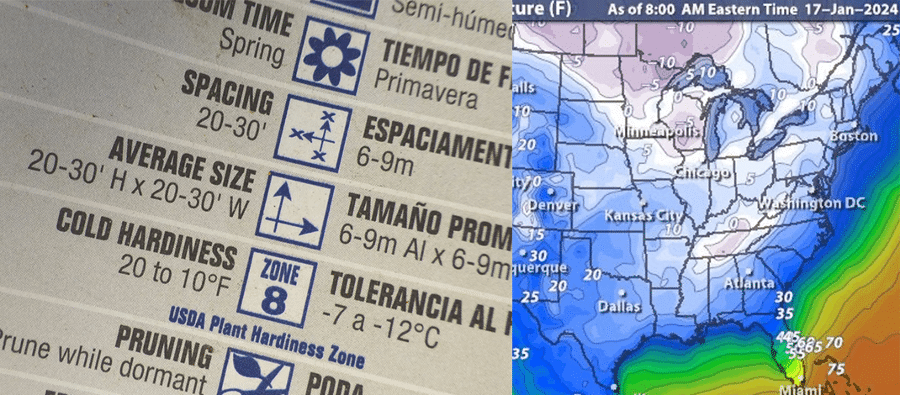Selecting zone-appropriate plants for your garden

We are sometimes quick to forget where we live when the snow has gone and we’re breathing in the sweet smell of a garden center.
Like many of you, I have a favorite / know it’s going to be good item at an eatery I frequent. But every once in a while, I find myself attempting to be adventurous and I choose the number 17 rather than the number 5. Sometimes the gamble pays off and my tastebuds are treated to party and other times I regret that I tried to crawl out of the rut. (Don’t you love it when I begin each one of these obscure rambles with a bizarre analogy?)
When we choose plants for our gardens, we occasionally also like to roll the dice. My goal for this writing is to open some eyes to choosing plants that will thrive in your zone. “What the fridge is a zone?”, some may utter. In botanical lingo, a zone is a defined area on a map on which it shows the minimum temperature a plant can handle before it either buys a plane ticket to Miami or it croaks.

On the left, a typical plant tag shows the minimum temperature this plant can handle. On the right, is a temperature map of our recent balmy winter.

I will confess that I am the head hypocrite when it comes to gardening. “Do as I say, not as I do.” I’ve given landscape design talks all over the south and I’ve preached “Do this, don’t do that. Can’t you read the signs?” (Sorry, listening to that 60’s playlist again on Spotify). In these talks, I’ve advised folks to always go with the tried and true, and then when I visit a garden center, I’ve caved and adopted that cute little “unusual” species that whispers “I’ll come home with you”. What saves me (and saves this writing from going off the rails) is I only gamble in moderation when it comes to purchasing a borderline plant. I will limit the number and I’m prepared to baby, move around, and take particularly good care of my new acquisition.
I am a huge fan of Daphne (and Scooby-Doo as well). Sorry, the dad jokes just keep flowing today. Of course, I’m talking about fragrant daphne (Daphne odora). The two I have spent the last week in the garage where the temperature bottomed out at around 20 degrees rather than -5 had they been outside. For me, the biggest reward for coddling these little guys is when I bring them inside around early February and allow their amazing fragrance to disguise a bit of that cabin fever funk that lingers when our windows are closed for long periods. Keeping borderline, warmer zone plants in mobile containers is the key to their longevity.
Something to keep in mind if you have a few container plants you never intend to sink in the ground is to remove them from their pots once in a while and see if the roots have maxed out the soil. If so, just pot them up with some good stuff in a slightly larger container. I know, someday these puppies will be too heavy to remain mobile. Then it may be time to will them to some younger / stronger friends.
On my morning walks, I noticed last summer a house nearby that was about to go on the flippers’ market. How do I know this? By the sheer number of tropical plants that were installed around the foundation. No doubt the flipper /seller was hoping some instant curb appeal would persuade a potential buyer with some curb appeal via some big, tropical blooms. Side note (surprise!), it’s always easy to spot a house about to be flipped. Very often it’s painted a hideous non-color (black and white) and salvage depot, crappy vinyl windows have been slapped up.

The planting on this cute house now looks a bit different after our big freeze. Most of the plants are/were tropical hibiscus.
So, back to plant hardiness. Spring will soon arrive and we’ll all be itching to run our chapped hands over some leaves of green. My advice is to be selective. If you find a plant that is marginal for your area (a zone 8 plant for your zone 7 location), rather than clean the shelf, buy only one or two and be prepared to keep them in mobile containers or plant them in a well-protected cubbyhole of a spot away from some bitter northwest winter blasts. Maybe near a south-facing wall or fence. This is what some refer to as a micro-climate.
One last thing to mention. Plant hardiness goes both ways. Not only do plants struggle with cold but many also can’t handle the heat. Raised in western New York, I am still a huge fan of lilacs. But getting one to thrive in our sauna-like summers is a tough gig. I am also noticing the decline of sugar maples in Tennessee. As our temperatures keep climbing, and sadly they will, keep this in mind when choosing which plants to add to your garden. Minimum nighttime summer temperatures aren’t yet noted on plant tags but it wouldn’t surprise me if someday they were.
Yes, when this winter is in the history books, we will all be on the lookout for perhaps something other than our usual menu item. Just remember, if you’re going to gamble, do so in moderation.
Please share and subscribe! https://ahomeforyourgnome.com/ (I promise you will only get a nudge about a new garden tip every two weeks)
Till next time,

